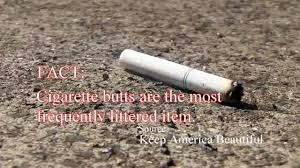How Cigarette Butts Pollute the Environment
Thousands of smokers don't think twice about leaving a trail of cigarette litter behind them. According to Keep America Beautiful (KAB), Americans are smoking fewer cigarettes than ever before, yet cigarette butts continue to be the most commonly littered item in the United States and around the world today.
A Plague on Our Planet
KAB specifies two reasons for this statistic—lack of awareness on the smoker's part, and the lack of availability of waste receptacles at transition locations, such as outside stores and other buildings, and at public transportation pickup spots.
Surprisingly, 77 percent of people in a survey by KAB responded that they didn't think of cigarette butts as litter. KAB also notes that for every public cigarette butt receptacle, cigarette litter drops by 9 percent in that area.
Cigarette Filters Are Bad for the Environment
The core of most cigarette filters, the part that looks like white cotton, is actually a form of plastic called cellulose acetate. By itself, cellulose acetate is very slow to degrade in our environment.
Depending on the conditions of the area the cigarette butt is discarded in, it can take 18 months to 10 years for a cigarette filter to decompose.
But that isn't the worst of it.
Used cigarette filters are full of toxins, which can leach into the ground and waterways, damaging living organisms that come into contact with them.
Most filters are discarded with bits of tobacco still attached to them as well, further polluting our environment with nicotine, which is poisonous.
Cigarette Filter Facts
Here are some additional facts about cigarette filters:
•Cigarette filters were designed to absorb some of the toxins in cigarette smoke and collect solid particles known as tar. They are also intended to keep tobacco from entering the smoker's mouth.
•Most cigarette filters contain a core of cellulose acetate and two layers of wrapping that are made of paper and/or rayon.
•Cellulose acetate fibers in a cigarette filter are thinner than sewing thread and a single filter contains more than 12,000 of these fibers.
•The inner wrapper on a cigarette filter is designed to either allow air to flow through it from the core for light cigarettes or to block airflow for regular cigarettes.
•The outer layer of paper is engineered to not stick to a smoker's lips and attaches the filter to the tube of tobacco.
•Chemicals are added to cigarette paper to control the burn rate, and calcium carbonate is added as a whitener, in part to create an appealing ash as the cigarette burns.
The Toxins in Cigarette Butts
Toxin-filled cigarette butts work their way into our waterways primarily through storm drains that dump into streams and lakes. Studies conducted by Clean Virginia Waterways have shown that just one cigarette butt in approximately two gallons of water is lethal to water fleas, a tiny crustacean found in freshwater and saltwater. And those tiny bits of tobacco left attached to cigarette filters carry more toxins than the filters do themselves.
Cigarette filters are a threat to wildlife that could ingest them, mistaking filters for food, and to small children, who may eat them if they're within reach.
The Threat of Fire
Discarded cigarette butts also pose a significant threat to our environment in terms of fire. Every year, forest fires ravage vast areas, killing off wildlife and vegetation that take years to return.
Some of those fires are started by natural causes such as drought, lightning, and the like. But according to the National Fire Protection Agency, smoking materials like cigarettes, pipes, and cigars, cause around 90,000 fires every year in the United States and are the number one cause of fire-related deaths.
Cigarette-induced fires claim hundreds of lives in the United States each year and injure thousands more, not to mention the millions of dollars that go up in smoke in property damage.
Staggering Numbers and Statistics
Think about this: One million is a large number, but when we're speaking in terms of billions (a thousand million in U.S. terms) and trillions (a thousand billion), the numbers are so large it's hard to truly fathom their proportions. As you read the following statistics, remember that most of the enormous numbers represented here are repeated yearly:
1.There are more than 1 billion smokers in the world today, and if current trends continue, that number is expected to increase to 1.6 billion by the year 2025.
2.China is home to more than 300 million smokers (one-third of the world's smokers) and they consume approximately 2.3 trillion cigarettes a year.
3.Worldwide, approximately 10 million cigarettes are purchased a minute, 15 billion are sold each day, and upwards of 5 trillion are produced and used on an annual basis.
4.Five trillion cigarette filters weigh approximately 2 billion pounds.
5.It's estimated that trillions of filters, filled with toxic chemicals from tobacco smoke, make their way into our environment as discarded waste yearly.
Taking the Steps to Quit
Everything—absolutely everything—about cigarettes threatens life on our beloved planet. They pollute the ground we walk on and the air we breathe. And if we smoke, cigarettes poison us slowly, stealing our quality of life long before they kill us.
If you're a smoker thinking about quitting, take steps today to put that last cigarette out and start a new chapter in your life. A chapter free of guilt and worry. A chapter filled with the self-empowerment that smoking cessation brings.
Yes, recovery from nicotine addiction takes some hard work early on, but with support and a plan, you can leave your smoking habit behind for good—both for your health, and the health of the planet.
